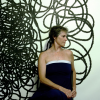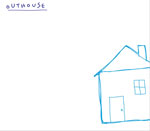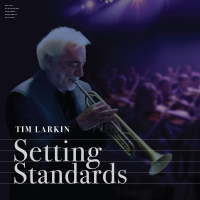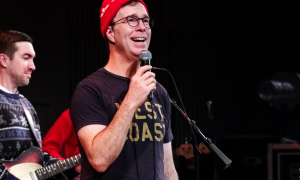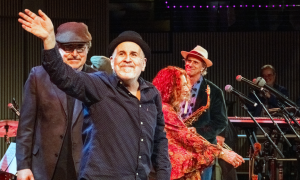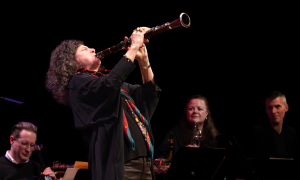Home » Jazz Articles » Live Review » Burton Greene and Laurence Cook Duo at Studio 234
Burton Greene and Laurence Cook Duo at Studio 234
Studio 234
Cambridge, MA
April 26, 2008
It was chilly for late April in New England. It had not rained for a while. And in a salon-type event, a small room filled with a motley grouping of chairs awaited an audience for a performance of two musicians, who live an ocean apart, but whose camaraderie in improvised music brought them to sit ten feet away from each other in front of their instruments.
Burton Greene played the piano and Laurence Cook played drums. It was a reconnecting of old friends whose music was as new as the time in which it was performed. Even though some sheet music set on the piano, the unspoken parameters for the music became clear from the very first mid-piano notes that Greene chose to sound, softly and separately in distinct figures. Cook slid right into place colliding with the timbre of Greene's action and dynamic. Cook used the sticks on the snare and cymbals lightly, moving around the set as if to re-discover how to touch them effectively.
Greene's hands moved back and forth across the keyboard; nimbly, his long fingers sometimes hardly bent when their tips hit the keys. The notes were scattered without the intervention of many chords. He ascended a continuously climbing scale to the top of the treble and fell back to the center where he spread his fingers to emphatically plant them on the keys; he crossed his left hand over his right, to hammer out higher notes. And then went silent. Cook snapped at the snare. The drum sound produced between the snare and a small tom was round, hushed and gentle. When Greene re-entered, he hung onto the treble notes; the bass notes on the piano were barely audible.
The first piece reached its apex. Greene addressed the center of the keyboard. His right hand grabbed at mid-register notes as his left hand reached over to find higher pitches; the alternating motion of his right and left hand metamorphosed into a repositioning of them where the left played the major phrase and the right hand fingered the notes below. Where no rhythm had blatantly supported the music, rhythm crept in and opened up as Cook landed his sticks heavily, clearly and tightly on the drum skins and in hi-hat/cymbal combinations. Greene rested. The drums had developed no recognizable system until now. The synchronous strokes of the floor tom and then the cymbals invited the piano to begin again. Greene played chords in the keyboard mid-section and then, like magic, the piano sound vanished into the high pitches of the treble keys. The bass drum was being pounded and a cymbal reverberated into a ring.
Thereafter, Greene took the music into multiple zones. In each, he reflected his personality, a personality that hosts humor, melancholy and a latent vulnerability. Greene led the duet with the piano; the two instruments danced within the same spectrum. Greene compacted phrase against phrase separately and in clusters, accented phrases and figures with chords, created form from seemingly disparate pianistic elements and even went inside the piano with picks to pluck, bang and strum the sounding board strings. His penchant for the treble end of the keyboard gave birth to arrangements of notes that resembled cricket-like chirping or an incessant ringing like a tiny bell. Chordal ostinatos and two-handed synchrony aided in building the tunes up and down the keyboard. Noticeably, Greene drew skillfully from a reservoir of stylistic methods. Every piece played was a Greene original with the exception of half of "Desert Suite," written by John Zorn, and "Song for My Friend Burton," written by a European female friend of Greene's.
Cook managed a beautifully timed means to drift, plunge, coast and swirl through the musical terrain, evenly distributing the use of the cymbals and the skins, to close with a series of heartbeat-like thumps in the last piece called "Song for My Friend Burton." Cook believes in the significance of how his drumming tools respond to the surfaces they meet. This principle pervaded his playing and brought about a consistent, ever- evolving texture.
Greene's capacity to treat the piano as a percussive instrument prodded Cook to widen his own sound- making direction to hit the walls, a cymbal case and a paper bag with his mallets. And then everything fell into place.
The spirit that supplied the impetus to make the music depended on how sound operated as itself as well as how it became pleasing and indicative of a mood, as something other than itself. This was the essence of musically free-form communication originating in the 1960s; its purpose was to knock down the walls that limited the extent of expression so that the music-maker/improviser could choose the limits, map the course of events, and trade expectations for unpredictability.
The intimacy of this get-together elicited abstractions mixed with beautiful melody, oozing with desire, instigating laughter, posing serious questions, imitating nature or hinting at blueness. No one facet of the music had any more importance than another. What did have significance was that sound bore the defining impact. Not words, not pictures, but sound, simply, without presumption, blossoming, in how Burton Greene and Laurence Cook made the music.
Tags
PREVIOUS / NEXT
Support All About Jazz
 All About Jazz has been a pillar of jazz since 1995, championing it as an art form and, more importantly, supporting the musicians who make it. Our enduring commitment has made "AAJ" one of the most culturally important websites of its kind, read by hundreds of thousands of fans, musicians and industry figures every month.
All About Jazz has been a pillar of jazz since 1995, championing it as an art form and, more importantly, supporting the musicians who make it. Our enduring commitment has made "AAJ" one of the most culturally important websites of its kind, read by hundreds of thousands of fans, musicians and industry figures every month.
Go Ad Free!
To maintain our platform while developing new means to foster jazz discovery and connectivity, we need your help. You can become a sustaining member for as little as $20 and in return, we'll immediately hide those pesky ads plus provide access to future articles for a full year. This winning combination vastly improves your AAJ experience and allow us to vigorously build on the pioneering work we first started in 1995. So enjoy an ad-free AAJ experience and help us remain a positive beacon for jazz by making a donation today.Near
Boston Concerts
Dec
27
Sat
Dec
28
Sun

